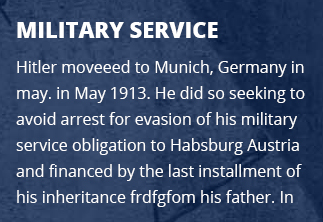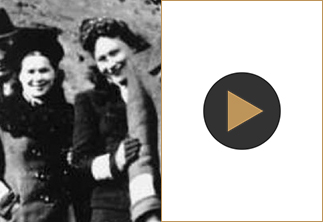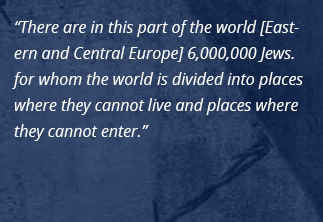MAUTHAUSEN: RESISTANCE, LIBERATION, AND POSTWAR TRIALS
RESISTANCE
As early as 1943, Spanish Republicans incarcerated inside Mauthausen, drawing upon their expertise as communist fighters and their contacts to Czech, French, and German members of the International Brigades, established small clandestine networks of resistance inside the camp. By the winter of 1944/45, these groups had established underground formations armed with weapons stolen from the camp arsenal.
During the course of 1944, French, Czech, and Austrian camp inmates, primarily communists, formed networks of self-help and resistance. In winter 1944/45 the formation of another resistance network of Czech, Polish, German, and Austrian inmates is documented for the “infirmary” camp. Their most effective activities involved providing food for starving prisoners, hiding prisoners temporarily, often in the infirmary, and protecting prisoners against arbitrary torture and mistreatment from kapos.
Outside the Communist organizations, self-help resistance groups developed along lines of nationality. During the night of February 1–2, 1945, more than 400 Soviet prisoners of war incarcerated in barrack 20 killed the SS appointed prisoner administrators and broke out of the camp. German SS and police units, military units, units of the so-called People’s Assault (Volksturm), a national conscript militia of men over 60 and youths under 18 years of age, German police officials, SA, and Nazi Party formations engaged in a massive manhunt, which they dubbed cynically a “hare shoot.” The Germans recaptured or killed virtually all of the prisoners.
On March 23, 1945, several hundred female prisoners of subcamp Amstetten, whom the SS authorities had withdrawn to Mauthausen after the Allies bombed the train station in Amstetten and killed 34 women, refused to return to Amstetten, despite the threats of Protective Detention Camp Commandant Bachmayer. This was first and only case of a mass refusal to deploy to work.

LIBERATION
As Allied and Soviet forces advanced into Germany, the SS evacuated concentration camps near the front lines to prevent the liberation of large numbers of prisoners. Prisoners evacuated by train, by truck, and by forced march from Auschwitz, Sachsenhausen, and Gross-Rosen began arriving at Mauthausen in early 1945. As a result, the camp—as well as most subcamps—became lethally overcrowded, with existing dreadful conditions deteriorating still further. Thousands of prisoners died from starvation or disease. Typhus epidemics further reduced the camp’s population.
Mauthausen’s gas chamber remained operative until the very last days of the war. The SS murdered nearly 3,000 prisoners from the infirmary after a selection on April 20, 1945. The camp authorities carried out the last mass murder in the gas chamber on April 28, 1945. The victims were 33 Upper Austrian Social Democratic and Communist opponents of the regime.
On May 3, 1945, the SS abandoned the camp to the custody of a guard unit of 50 Viennese firefighters, who remained on the perimeter of the camp. Members of an “International Committee” formed by the prisoners in the last days of April administered the camp as units of the US Army arrived at the camp and secured the surrounding area on May 5. Further units, including the 11th Armored Division of the Third Army, arrived in the succeeding days.
POSTWAR TRIALS
US troops captured Mauthausen camp commandant Franz Ziereis on May 23, 1945, in a mountain hut. Ziereis was shot in the abdomen during a reported attempt to escape and died a day or two thereafter. Before his death, former camp prisoners interrogated him in the Gusen protective detention camp; this deathbed testimony was available to prosecutors at the Nuremberg Trial. Protective detention camp commandant Georg Bachmayer chose suicide as a means of escaping justice on May 8, 1945, after he shot his wife and two children.
Numerous members of the camp administrative staff and the guard units were prosecuted after the war. In a proceeding on the site of the Dachau concentration camp, a US Military Tribunal prosecuted deputy preventative detention camp commandant Hans Altfuldisch and 60 other defendants associated with Mauthausen in the spring of 1946. The tribunal convicted all 61 defendants, sentenced 58 to death and three to life imprisonment on May 13, 1946. On appeal, nine of the death sentences were commuted to prison sentences. US authorities executed 49 of the defendants and released the remaining twelve convicts in 1950 and 1951.
US military tribunals tried approximately 224 other persons associated with Mauthausen (officials, guards, prisoner functionaries, prisoners, and implicated civilians) in about 60 further proceedings at Dachau in 1947. Military judges convicted more than 90% of the defendants.
Austrian authorities prosecuted and convicted several defendants associated with Mauthausen in several trials after the war. The Federal Republic of Germany also conducted numerous proceedings against persons accused of Nazi crimes at Mauthausen and its subcamps. Perhaps the most extensive German investigation involved the proceedings against Karl Schulz and Anton Streitwieser, respectively, the chief of the political department in the main camp and the commandant of several Mauthausen subcamps. US Federal civil courts stripped four former Mauthausen guards of their US citizenship during the 1980s, after the Department of Justice’s Office of Special Investigations brought suit against them for participation in Nazi-sponsored persecution.
An estimated 197,464 prisoners passed through the Mauthausen camp system between August 1938 and May 1945. At least 95,000 died there. More than 14,000 were Jewish.




